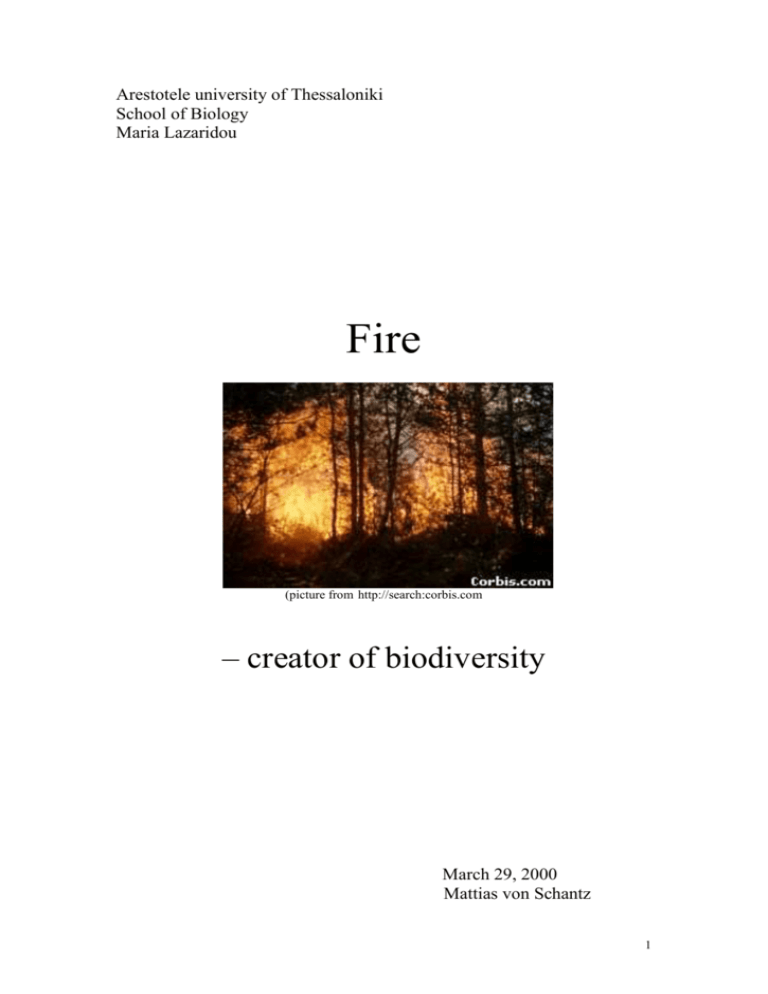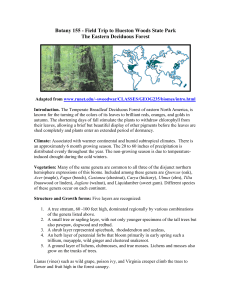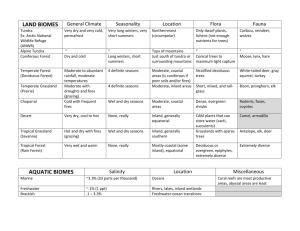Forest fires, creator of biodiversity
advertisement

Arestotele university of Thessaloniki School of Biology Maria Lazaridou Fire (picture from http://search:corbis.com – creator of biodiversity March 29, 2000 Mattias von Schantz 1 Contents Contents……………………………………………………………..2 Creator of biodiversity………………………………………………3 Short description of the Swedish biomes and landscape……………3 Fire, a natural disaster……………………………………………….5 Succession in a conifer forest after a forest fire……………………..5 The phyrophilous fauna……………………………………………..6 Metapopulations…………………………………………………….7 Fire and foresting……………………………………………………8 Bibliography…………………………………………………………9 2 Forest fires, creator of biodiversity In Sweden, as in many other countries, the fire is the most important natural disturbance in the terrestrial parts of nature. This has resulted in special adaptations within species. These species can’t survive without the special conditions that the fires caused and they are the first ones to colonize the devastated area and start succession all over. This is one of the ways fire contributes to the variability and the biodiversity in the forest. Until the end of the 19th century approximately one percent of the Swedish forest burned down every year. Today this has decreased to only a small amount of the recent given percentage. The main reason for this is today’s firefighting and modern foresting. Since the debate about nature conservation started in Sweden, more ecological knowledge has been used in foresting. Scientists have come up with a planning model for nature-modified foresting. Also large foresting-companies set out to burn a small part of their forest, wish is done to preserve the diversity of the forest. Short description of the Swedish biomes and the landscape About 60% of Sweden’s 41 million acres consists of forest. Sweden has the second largest area in Europe and is divided into three large biomes; temperate deciduous forest, boreal forest and tundra. Temperate deciduous forest grow in continental climates with summer rainfall and severe winters. They are dominated by broad leaved deciduous trees and are found in Europe, Asia and the Americas. (picture from Sveriges nationalparker; se bibliography) Deciduous forest outside Dalby 3 Boreal forest is also known as taiga. It extends from north-eastern Europe across Russia to the Pacific Ocean, and right across North America from Alaska to Newfoundland. Snow lies on the ground for much of the year. The soil-type is classed as podzolic, meaning it has a high quantity of humus an acidic pH. The vegetation of the boreal forest is dominated by conifer trees whish are evergreen with the exception of the larches. The important genera are the pines, spruces, firs and larches. Some broad leaved species also occur, notably poplars (Populus spp) and Birches (Betula spp). With its harsh winters, the taiga poses severe problems for the animals found in it. Some of the birds and the mammals migrate. Some remain active during the long dark winter, and some of the mammals hibernate. Most of the invertebrates survive as resting stages, typically eggs or pupae. (picture from Sveriges nationalparker; se bibliography) Boreal forest in the center parts of Sweden The northern part of Sweden is covered with low treeless vegetation known as tundra. The growing season is to short, the winters too long and dry, and the soil too unstable to support trees. Primary production is low. One of the most important factors that has formed the landscape is the inland ice from the Ice age 10 000 years ago. This has resulted in a lot of small lakes, archipelagoes and a flat landscape. In the northern parts of Sweden the Scands rise to about 2 800 m above the sea, and are still rising due to the inland ice. The southern part is sinking by some mm every year. The amount of cultivated field decrease to the north. In the southern parts of Sweden the forest became cultivated field almost 6 000 years ago and in the north we keep foresting into almost untouched forest. The frequency of fires is most abundant in the south-eastern part and lowest in the north-west. 4 Fire, a Natural disaster Fire is classed as a natural disaster and is one of the factors that regulate population size and increase the biodiversity. They are uncommon and unpredictable events that are influenced by hot dry periods and caused in nature by lightning strikes. The frequency of fires varies between centuries depending on large scale climate change. The effects of disasters on populations are considerable. A fire may wipe out many species in the vicinity of the disaster. New populations may then be established by immigrants from neighboring populations. Survivors in seed-banks may provide the next generation for the plant populations. If these have also been destroyed, fresh incoming seeds are required to colonize the area. Other species may colonize the habitat. It may then be some time before populations of the original species re-invade the site. Succession after a fire in a conifer forest In a forest fire a lot of nutrients get released and the pH rises in the area. This results in bacteria’s and fungi growing rapidly whish attracts insects in great numbers. Many of the invertebrates live or leave their eggs in the nutritious part between the wood and the bark in the trees that got killed in the fire. Many plants starts to grow rapidly. Seeds and roots can survive a few cm under the ground during the fire. Some plants need over 50 degrees C to start to grow and therefor depend on the fire. (picture from http://search:corbis.com) Fluorescing burnt pineforest Beech, Aspen and other deciduous trees are favored one behalf of the conifer trees. 20 years after the fire, many of the unique invertebrates that were favored by the fire have started to search for new forest fires. After a while the conifer trees start to compete with the deciduous forest for space. Dead and moldering deciduous trees attracts wasps, bees and other insects. This makes it a perfect environment for woodpeckers. After 70-70 years the conifer trees have reestablished and taken over the community again, it is the climax community. 5 The phyrophilous fauna There is about thirty insects that are phyrophilous and are attracted to burning or newly burnt forests. Some of these are the following: Anthocoridae Scoloposcelis obscurella. Found in many places in Sweden in newly burned forests and is most abundant about two years after the fire. They arrive soon after the fire. There offspring grow under the bark on newly dead conifer and deciduous trees, where they eat eggs and larvae from flies and mosquitoes. Butterflies: Pyralidae Apomyelois bistreslla. A small soot-black moth (25-30 mm between the wingtips) which arrives the same day as the fire. It develops commonly inside the fungus Dalidinia concentrica (Ascomycetes: Pyrenomyctidae) which grow on burnt birches. Beetles: Carabidae Sericoda (Agonum) quadripunctata is the most abundant specie of Carabidae that is phyrophilous. Grown animals fly to burnt forests between May and July. The larvae lives as predators in moistly, burnt litter, often where mosses like Ceratodon purpureus and Polytichum commune (mosses) soon will grow. They are most abundant one or two years after the fire. Buprestidae Melanophila acuminata is sometimes found in great numbers in newly burned areas as they copulate in 60-70 degrees C where there is still a fire. In spite of its demands on warm places to grow, it is more abundant in higher areas. The specie is very local and is located in regions with high firefrequency. The phyrophilous insects are unique in many ways. In there special habitat, burnt forest, many species have a wide field of taking advantage of different substrates. This is probably because of their narrow kind of habitat. Other ways to broaden the nish width is, within species that live in the wood, to be living of the tree during a longer time in the process of subversion. Also that they have a long period of activity is a way to widen there lifespace. The time of whish the fire occurs has a certain meaning considering whish species that are going to colonize the area. Both burnt cutting areas and natural fires can occur from May to September. Many insects have there most important faze of spreading during the early summer, whish also includes many phyrophilous insects. Most fire insects though has a very extended time of clustering. When there is fires as late as the second half of August, the phyrophilous insects are the dominating species. Few other species, specially among wood living insects are active during this time. Generally the diversity of invertebrates is significantly lower in higher areas than in lower burnt areas. Some phyrophilous insects does not follow this negative trend of diversity with increasing height. This is paradoxical as fireinsects at the same time is supposed to be favored by a warm microclimate. The reason why some species are moving north is probably because there are more fires due to the efficient firefighting in the south. Also phyrophilous animals are in great need of a competitive free environment. In climatic unfavorable conditions, the competition is seldom as intense because most species populations repeatedly get 6 reduced by the cold periods. This is where fireinsects can use there superior way of spreading and be the first ones to colonize newly dead trees. In warmer regions the number of competitors are much greater. The only way for the phyrophilous insects to be competitive here is if there is a high firefrequency. Metapopulations Even if many fireinsects are good at spreading, there is still a certain distance that they can’t cross. This fact, and the fact that they only live in burnt forests makes them a kind of “metapopulations”. Metapopulations is a group of populations with a small exchange of individuals between them. In such a system of many small populations, everyone has a small risk of being extinct. These extinctions is compensated by a certain colonization from the areas nearby. The conclusion of this is: you can protect all occurrences of a specie and still it will go extinct. Four factors has been proved to be specially important to explain where an organism occur / doesn’t occur, in an environment that is split up into many small peaces. These are: ability to spread distance to the nearest area where the specie occurs the greatness of the area the quality of the area. An exchange between areas is a postulation for a working metapopulation to: “repair” random extinctions and stop interbreeding The quality of an area, and if the quality changes during time, are other key-factors for the survival of every separate area in a metapopulation. Many species today have a population that is doomed to get extinct because of isolation and to small populations. These are known as “the living dead”. The Dendrocopos leucotos (woodpecker) in Sweden is known as such a specie because of its dependence of burnt forests. (pictures from L. Jonssons Foglar I Europa 1992) Dendrocopos leucotos The spreading of the Dendrocopos leucotos 7 Fire and foresting In Sweden the fire has been used since the stone-age to prepare the ground. Partly to prepare the ground to grow in (burn beating), partly to make the forest grow better (burnt clear cutting). The modern foresting with forest-machines made the burnt clear-cutting areas dramatically decrease during the 1960ies. Today MoDo, a large Swedish forestingcompany, has set out to burn 5% of the clear-cutting area they produce every year, only to preserve the diversity of the forest. At the same time scientists has come up with a planning-model for nature modified foresting, whish is called the ASIO-model. ASIO is Swedish short for never, seldom, sometimes and often. This stands for in what risk-zone the forest is in. The different classes depends on factors that influence the fire-frequency, as the degree of moisture in the ground and the ground-vegetation. Every class has a special way to be treated in. According to the ASIO-model the foresting should give shape to imitate the natural disturbances on respectively areas. Has the burning of the clear cuttings any effect? According to Lars-Ove Wikars in Entomologisk tidskrift: they seem to favor some species. Burned clear-cuttings does not give the same positive effects on the multiplicity as a natural fire, but has helped to create good environments for many insects and plants. The range of these fires are large. From the burning of clear cuttings with single trees to clump of trees or trees standing along the sides. Partly cut or uncut forest. There is no exact definition of nature caring forest fires but the main reason is nature caring and not production. One fact that influence the phyrophilous insects is when the burning of the cut areas is preformed. Often the foresting companies wait one year and a half, after they cut down the trees, to burn the clear cutting. This means that many insect generalists have time to invade and grow into great numbers that, after the fire, make them more competitive. Another reason to burn forest instead of clear cuttings is that burnt forest offers more substrate for the insects, during a longer period of time, compared to cleared cutting. Because of the time and space range between forest fires these metapopulations of Phyrophilous insects are about to be extinct in Sweden. To make fire insects and other species favored by fire able to survive in a long-term in Sweden, probably more untouched forest is needed. Also an increased degree of deciduous trees, burnt forest in nature reserves and to make nature caring forest fires on tree rich clear cuttings. 8 Bibliography Skog och forskning (1991); (193); 1:34-41 Angelstam:Per : Aldrig, sallan, ibland, ofta. Etomologisk tidskrift/ Umeo Sveriges ent 1880 (1997); 4:155-169. Wikars, L O: Brandinsekter I Orsa Finnmark Jordbrukarnas foreningsblad med Lanthemmet. (1997); 37; 4-7 Strom: Hokan: Hettan tander baggens lust. Teknik och vetenskap (1998) 3; 23-26 Bergman: Karl-Olof: Att leva I en varld som gott I bitar Skogen/ den obundna skogstidningen. (1995); 1; 36-38 Angelstam: Per: Alla kan harma naturlandskapet. Ecology principles and applications, second edition Cambridge university press 1999 Sveriges nationalparker, naturvordsverket Bokforlaget Prisma 1983 Foglar I Europa by Lars Jonsson 1992 po341 9








